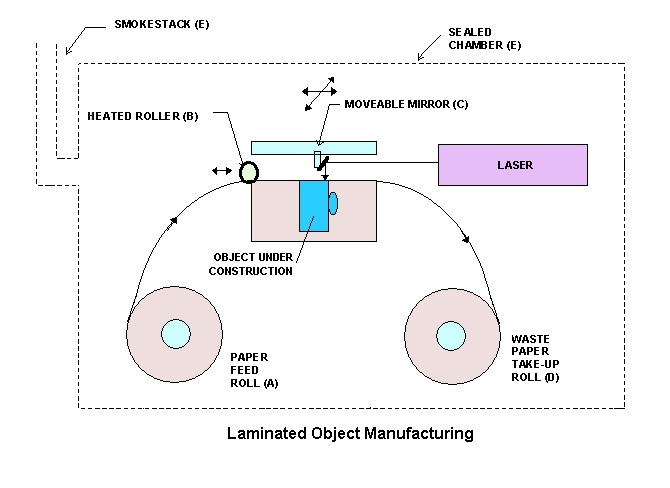What is Laminated Object Manufacturing?

Laminated object manufacturing (LOM) is a method of 3D printing. It was developed by the California-based Helisys Inc. (now Cubic Technologies). During the LOM process, layers of plastic or paper are fused — or laminated — together using heat and pressure, and then cut into the desired shape with a computer-controlled laser or blade.
While LOM is not the most popular method of 3D printing used today, it is still one of the fastest and most affordable ways to create 3D prototypes.
What is 3D printing?
First developed in the 1980s, 3D printing — or additive manufacturing — refers to several different methods of creating three-dimensional objects from computer-aided design (CAD) files. Engineers, designers and product development teams use 3D printing to quickly and inexpensively create prototypes that can be tested for form and function. This allows them to improve an object's design before it is manufactured on a large scale.
How LOM works
Like all 3D-printed objects, models made with an LOM system start out as CAD files. Before a model is printed, its CAD file must be converted to a format that a 3D printer can understand — usually STL or 3DS.
An LOM apparatus uses a continuous sheet of material — plastic, paper or (less commonly) metal — which is drawn across a build platform by a system of feed rollers. Plastic and paper build materials are often coated with an adhesive. To form an object, a heated roller is passed over the sheet of material on the build platform, melting its adhesive and pressing it onto the platform. A computer-controlled laser or blade then cuts the material into the desired pattern. The laser also slices up any excess material in a crosshatch pattern, making it easier to remove once the object is fully printed.
After one layer of the object is formed, the build platform is lowered by about one-sixteenth of an inch — the typical thickness of one layer. New material is then pulled across the platform and the heated roller again passes over the material, binding the new layer to the one beneath it. This process is repeated until the entire object has been formed.
Once an object is done "printing," it is removed from the build platform, and any excess material is cut away. Objects printed in paper take on wood-like properties, and can be sanded or finished accordingly. Paper objects are usually sealed with a paint or lacquer to keep out moisture.
Get the world’s most fascinating discoveries delivered straight to your inbox.
[See also: Resin: The Next Little Thing For 3D Printing]
What gets made
While LOM does not create models that are as accurate as those created with other 3D printing methods — like stereolithography (SLA) or selective laser sintering (SLS) — it does offer certain advantages. Because the LOM process doesn't involve any chemical reactions, no enclosed chamber is needed, making it easier to build large models. The materials used during LOM are also inexpensive, consistent, readily available and well understood.
However, LOM is not ideal for creating objects with complex geometries, and it can't create hollow objects. Because this process doesn't produce highly accurate parts, it can't be used to create functional prototypes. For this reason, LOM is used primarily for creating scaled models and conceptual prototypes that can be tested for form or design. It can also be used to make patterns for use in traditional manufacturing, such as sand molded casting, a metal casting process.
Companies using LOM
The first LOM rapid prototyping system was developed by Helisys, Inc., a company that ceased operation in 2000. Cubic Technologies now sells, services and supports Helisys' products. Other companies specializing in LOM printing have also closed their doors in recent years, including the Israel-based Solido 3D and Kira, Inc. in Japan.
However, at least one company is trying to bring LOM back into the mainstream. The Irish company Mcor Technologies Ltd. sells professional 3D printers that use LOM technology to create objects with standard Letter/A4 paper. Its machines are used by architects, artists, product developers and even doctors to produce affordable models and finished goods.
While not as prevalent as other methods of additive manufacturing, LOM is still offered by several companies that also provide other 3D printing services.
LOM at home
Most of today's desktop 3D printers use a process known as fused deposition modeling (FDM), in which plastic is heated to its melting point and then extruded, layer by layer, to produce a three-dimensional object. However, there are desktop 3D printers that use the laminated object method.
Cubic Technologies sells a desktop LOM printer from hardware manufacturer Solidimension Ltd. The SD300 3D printer produces objects in an engineered plastic material. But at $14,995, this printer is not as affordable as its FDM counterparts, such as the MakerBot Replicator or 3D System's Cube, which cost between $1,300 and $2,200.
However, LOM printing may receive a new lease on life thanks to the pioneering Mcor Technologies. Mcor recently partnered with Staples, the office supplies retailer, to provide customers with access to affordable, in-store 3D printing. Customers can upload their own designs to be printed or they can choose from a variety of pre-designed objects, like light fixtures, jewelry or cell phone cases. All objects are printed in paper on Mcor's full-color LOM printer, the IRIS.
Follow Elizabeth Palermo on Twitter @techEpalermo or on Google+. Follow LiveScience @livescience. We're also on Facebook & Google+.
Further reading:


